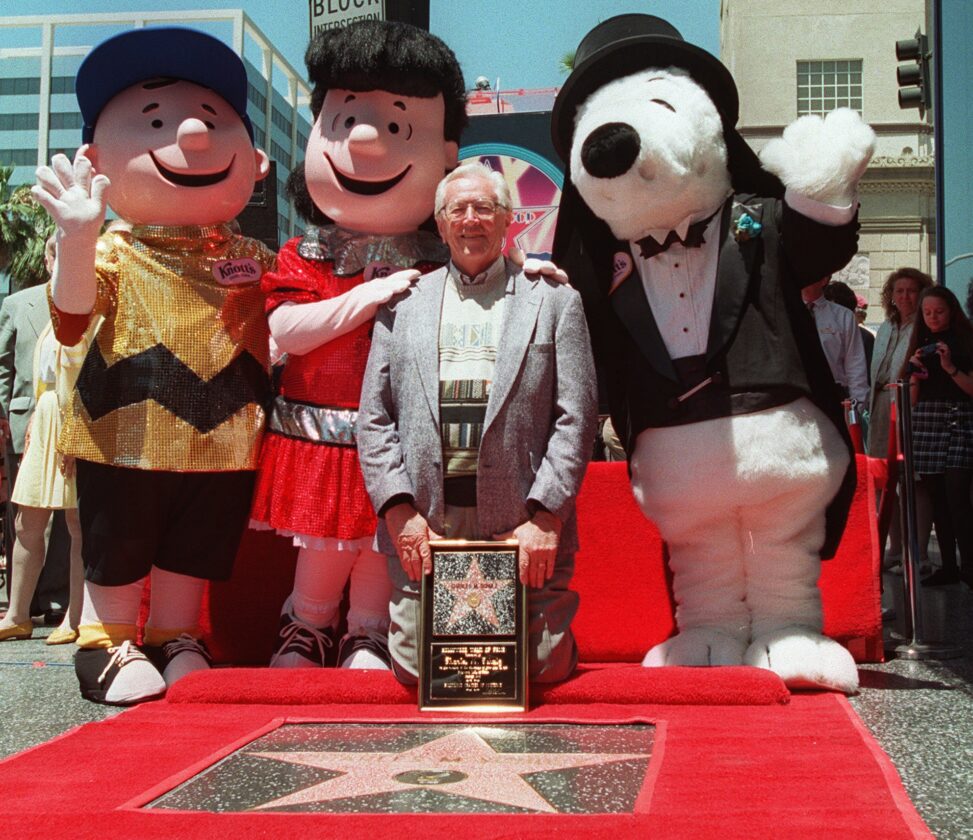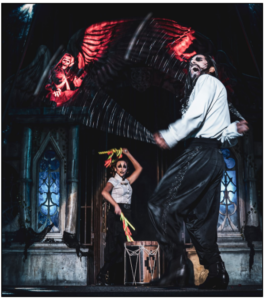Comic Strip Peanuts Notes 75th Anniversary

"Peanuts" creator Charles M. Schulz is joined by his characters Charlie Brown, Lucy and Snoopy, left to right, after his star was unveiled on the Hollywood Walk of Fame in the Hollywood section of Los Angeles Friday, June 28, 1996. "Pretty good for a cartoonist," Schulz said. (AP Photo/Susan Sterner)
Oct. 2 is a big day in my house. It’s first and foremost my wife’s birthday. It’s the anniversary of Bucky Dent’s home run during the Yankees’ one-game playoff win at Boston in 1978 — my mom and I skipped school and work to watch it. And for me and for millions of other fans, it’s the anniversary of the first appearance of Peanuts in newspapers. Today is the 75th year, with the first strip having appeared on October 2nd, 1950 in just 7 newspapers. Humble beginnings for what would become an enormous pop-culture empire in more than 2,600 newspapers worldwide.
Charles M. Schulz was a World War II veteran — and part of the D-Day landings — from St. Paul, Minn. After the war, this aspiring artist sold some single-panel comics to the Saturday Evening Post, and was soon pitching his strip (then billed as “L’il Folks”) to newspaper syndicates. Finally in 1950 United Features inked him, but because the L’il Folks name was similar to the already-popular L’il Abner strip, the syndicate essentially forced the name “Peanuts” on him. Schulz hated the name (and always would), but he went along with it. The final strip ran on Feb. 13, 2000, the morning after Schulz himself passed away — a run of more than 17,800 strips.
Even before all the merchandising, Peanuts was a hilarious comic strip, and there are 60- and 70-year old strips that would make people laugh out loud even today. Lucy’s psychoanalysis of Charlie Brown, the conferences on the pitcher’s mound, Snoopy’s wild imagination, Peppermint Patty’s classroom struggles, new and better ways to agonizingly lose, are all relatable and very funny.
It was also subversive. Throughout its run, the strip showed girls playing baseball with boys, years before that became more commonplace. Characters quoted from scripture and classic novels and performed classical music. Charlie Brown and Snoopy did not have anything like a typical human/dog relationship.
The strip could also be very deep and make lasting impressions. One strip that stayed with me for most of my life was a Sunday strip in which Linus sees a thrilling end to a football game and goes running out to tell Charlie Brown all about it in great detail. When he’s done, Charlie Brown asks “How did the other team feel?” I read that at a young age, and whether playing little league, varsity tennis, Risk, or fantasy football, I’ve always remembered that response and tried to temper my trash talking (sometimes).
Another poignant moment came at the end of A Boy Named Charlie Brown, the first feature film. Charlie Brown (spoiler alert) lost a spelling bee on a word he should have known, and hid in his room the entire next day. But Linus stops by to say hello, and tells him that “The world didn’t come to an end.” That’s a hard lesson for a kid, or for an adult. And as you can imagine, that’s the kind of sentiment that helps get someone through losing their own sixth grade spelling bee, the Yankees’ 2004 ALCS collapse, or for Bills fans, wide right. Yet it was never preachy or moralizing, it was just natural behavior for these characters.
I can’t remember a time when Peanuts wasn’t a part of my life. Sheets, stuffed animals, board games… almost always Peanuts-themed. I had my share of children’s books, but always went straight to the Fawcett Crest Peanuts collections, of which I still have more than 80 of the 100 that were published. I’ve never known a holiday season without “A Charlie Brown Christmas,” even learning all of Linus’ lines for the fourth grade Christmas play. As an adult, my office has Peanuts memorabilia on the walls, desk and shelves, and I put out more than 70 ornaments on display for the holidays too. “Charlie Brown’s All Stars” is the best animated special you’ve never seen, and the baseball strips alone would make a fantastic collection.
Even my employer — State University of New York at Fredonia — seems to be a fan. When three new residence halls were opened in 1970 (around the strip’s 20th anniversary), students were given the chance to vote on their names, and they chose to name them after (Jimi) Hendrix, (Walt) Disney, and (Charles M.) Schulz — fitting for a campus with such strong fine arts programs.
More recently, since the characters are children, the Schulz family seems to be making new material aimed more at kids than the strip and early TV specials were. That’s fine… and I hope that when those kids grow up they’ll discover the rich treasure trove of strips that started it all, and have an even deeper appreciation for it.
Chris LaGrow is a Fredonia resident and a part-time Bracketologist during the NCAA college basketball season.





